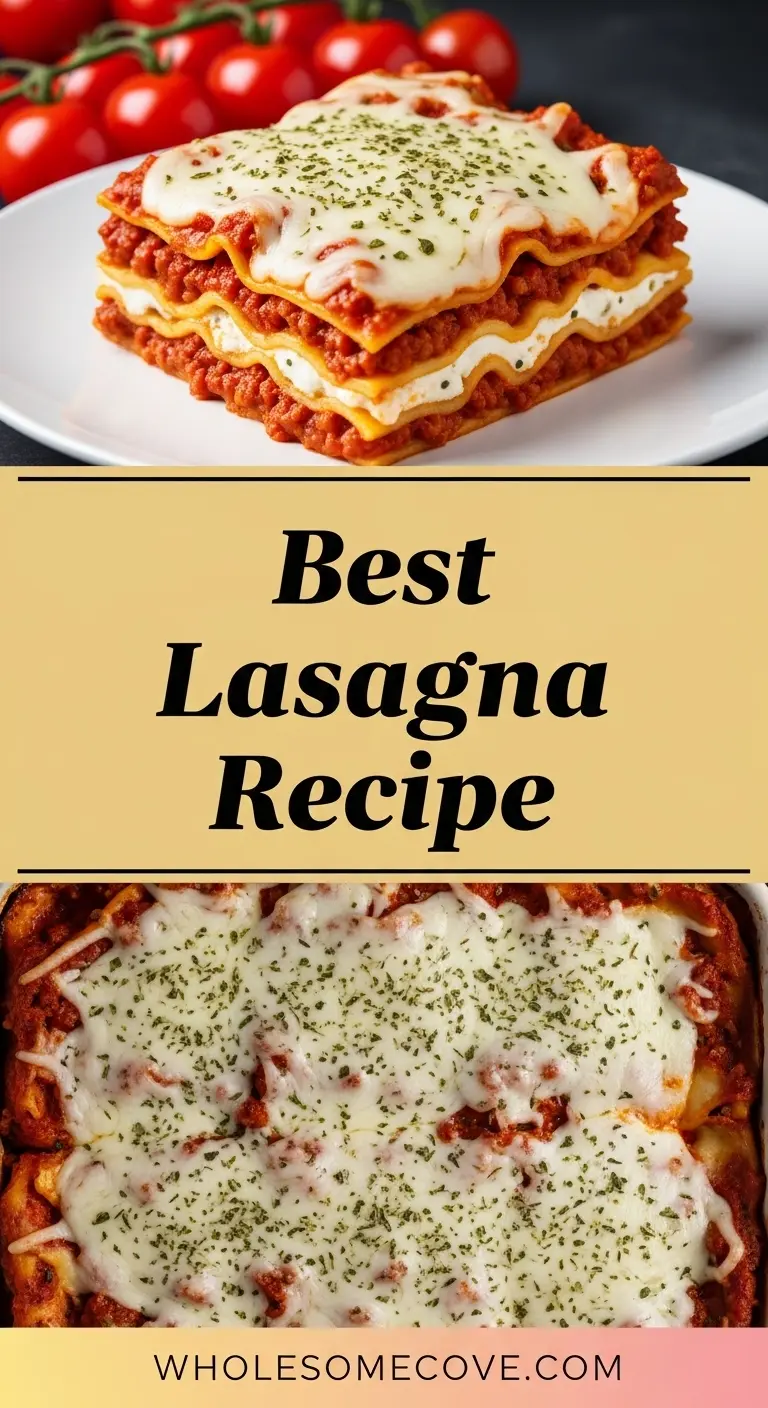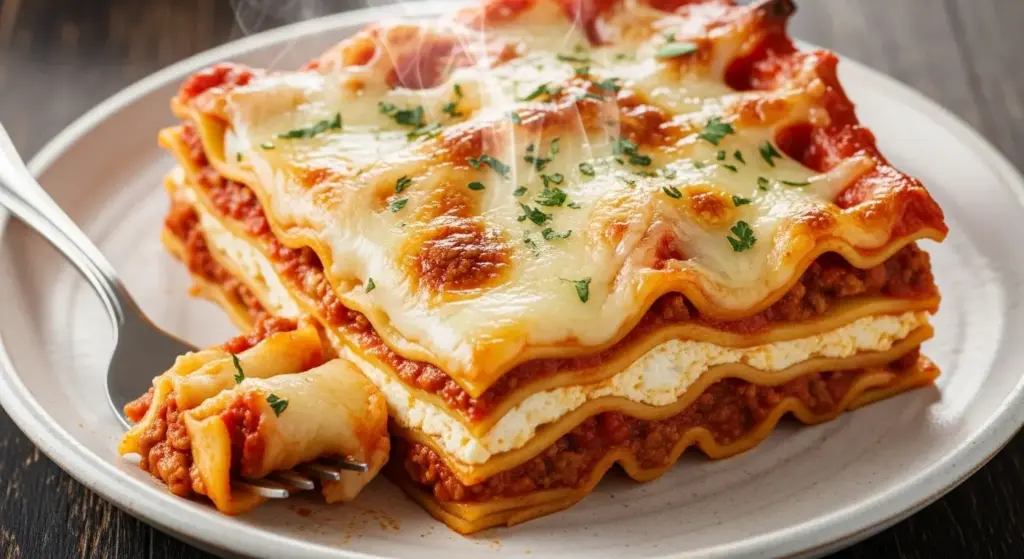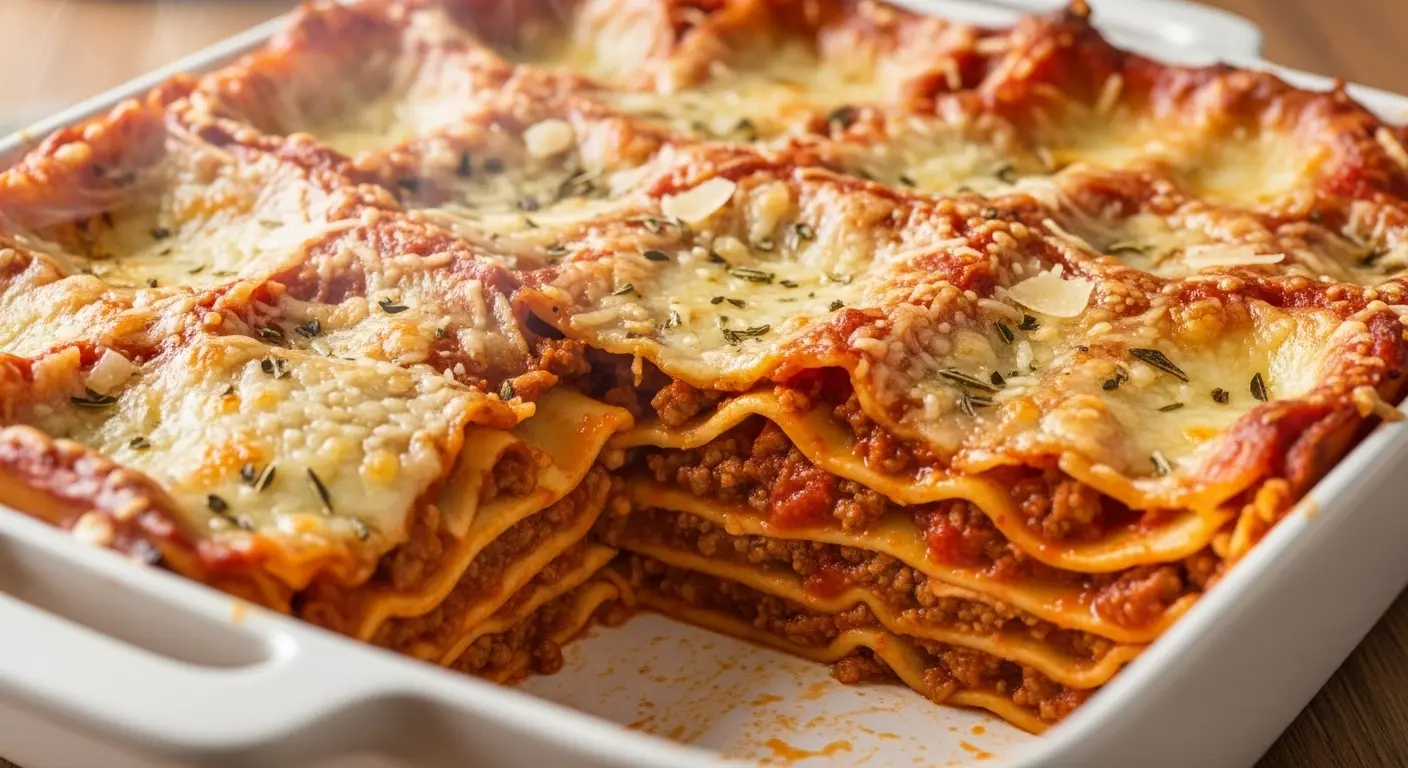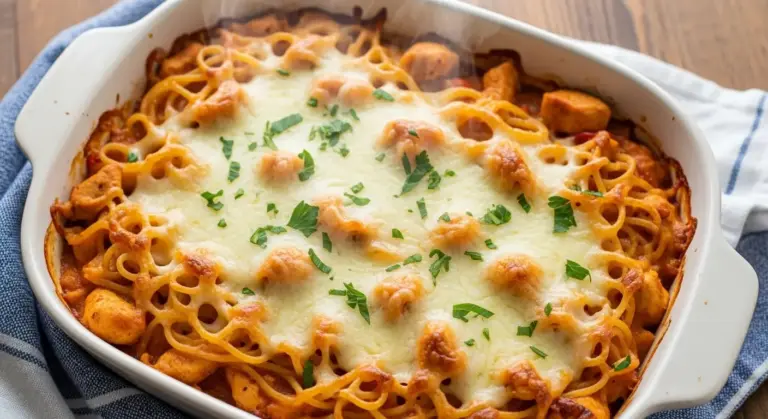I’ll never forget the first time I attempted to make lasagna from scratch. It was my mom’s birthday, and I wanted to recreate the comforting dish she’d been making for our family for decades.
I botched it spectacularly—burnt edges, watery center, and cheese that looked more like rubber than the melty, golden perfection I’d envisioned. But instead of giving up, I spent the next year perfecting this lasagna recipe, learning from every mistake and tweaking every layer until I got it just right.
Now, this dish is the star of every family gathering, and I’m excited to share all my hard-earned tips with you.
| Quick Recipe Summary | |
|---|---|
| Prep Time | 30 minutes |
| Cook Time | 1 hour |
| Total Time | 1 hour 30 minutes |
| Servings | 8-10 servings |
| Difficulty Level | Medium |

Why You’ll Love This Lasagna Recipe
This isn’t just another lasagna—it’s the kind that makes people go quiet at the dinner table because they’re too busy savoring every bite. The layers are perfectly balanced with rich meat sauce, creamy ricotta, and just the right amount of cheese that gets beautifully golden on top.
What makes this recipe special is how forgiving it is. I’ve learned that lasagna actually improves if you make it a day ahead, which means less stress when you’re hosting.
The ingredients are straightforward and easy to find at any grocery store. No fancy techniques or hard-to-pronounce Italian terms—just honest, delicious comfort food that anyone can master.
Here’s what you’ll love most:
- Make-ahead friendly: Assemble it the night before and pop it in the oven when guests arrive
- Crowd-pleaser: I’ve never met anyone who doesn’t love this dish, from picky kids to sophisticated foodies
- Freezer-friendly: Make two and freeze one for those nights when cooking feels impossible
- Customizable: Swap the meat for vegetables, try different cheeses, or add your favorite herbs
- Budget-friendly: Feeds a crowd without breaking the bank
If you enjoy hearty Italian comfort food, you might also love my best sausage tortellini soup recipe for cozy weeknight dinners.
Ingredients
The secret to outstanding lasagna starts with quality ingredients. I learned this the hard way after using bargain-bin ricotta that turned grainy when baked.
Now I’m particular about my cheese and always opt for whole milk ricotta and freshly grated Parmesan—the difference is night and day.
For the Meat Sauce:
- 1 pound (450g) ground beef (80/20 blend works best)
- 1 pound (450g) Italian sausage, casings removed
- 1 medium yellow onion, finely diced (about 1 cup/150g)
- 4 cloves garlic, minced
- 1 can (28 ounces/794g) crushed tomatoes
- 1 can (15 ounces/425g) tomato sauce
- 2 tablespoons tomato paste
- 2 teaspoons dried basil
- 2 teaspoons dried oregano
- 1 teaspoon sugar (balances the acidity)
- 1 teaspoon salt
- ½ teaspoon black pepper
- ½ teaspoon red pepper flakes (optional, for a subtle kick)
For the Cheese Mixture:
- 32 ounces (907g) whole milk ricotta cheese
- 2 large eggs
- ½ cup (50g) grated Parmesan cheese
- ¼ cup (15g) fresh parsley, chopped
- 1 teaspoon salt
- ½ teaspoon black pepper
- ½ teaspoon garlic powder
For Assembly:
- 12-16 lasagna noodles (depending on your dish size)
- 4 cups (450g) shredded mozzarella cheese, divided
- ½ cup (50g) grated Parmesan cheese for topping
- Fresh basil leaves for garnish (optional)
Kitchen Equipment Needed
Having the right tools makes lasagna assembly so much easier. I used to struggle with a flimsy casserole dish until I invested in a proper deep baking dish—it holds all those gorgeous layers without overflow.
Here’s everything you’ll need:
- Large skillet or Dutch oven: For making the meat sauce (at least 5-quart capacity)
- Large pot: For boiling the lasagna noodles
- 9×13-inch baking dish: A deep ceramic or glass dish works best (at least 3 inches deep)
- Mixing bowls: One large bowl for the ricotta mixture
- Colander: For draining the noodles
- Wooden spoon: For browning the meat and stirring sauce
- Measuring cups and spoons: For accurate measurements
- Cheese grater: If you’re grating your own cheese (highly recommended)
- Ladle or large spoon: For layering the sauce
- Aluminum foil: For covering during baking
- Cooling rack: For letting the lasagna rest before serving
Recommended Products for This Recipe
After making this lasagna recipe countless times, I’ve found a few products that genuinely make the process easier and the results even better. These aren’t just nice-to-haves—they’ve become staples in my kitchen.
1. Le Creuset Enameled Cast Iron Baking Dish
This baking dish has been my go-to for years now. It distributes heat so evenly that you’ll never deal with burnt edges or an undercooked center again. The 3.5-quart capacity is perfect for a generous family-sized lasagna, and cleanup is incredibly easy even with all that baked-on cheese.
2. San Marzano DOP Whole Peeled Tomatoes
I switched to these authentic Italian tomatoes last year, and I can’t go back to regular canned tomatoes. They’re sweeter, less acidic, and have this rich flavor that makes your sauce taste like it simmered for hours. Just crush them by hand for the best texture in your meat sauce.
3. Microplane Premium Classic Zester Grater
Freshly grated Parmesan makes such a difference in both the ricotta mixture and the final topping. This grater is razor-sharp and makes quick work of hard cheeses. I use mine for nutmeg and citrus zest too, but for lasagna, it’s essential.
4. Lodge 6-Quart Enameled Dutch Oven
Perfect for making the meat sauce without any splattering mess. The heavy bottom prevents burning, and the generous size means you can brown the meat properly without crowding. It goes from stovetop to table beautifully if you’re making sauce for a crowd.
You might also enjoy: marinara sauce recipe
Step-by-Step Instructions: How to Make Lasagna
I’m walking you through every single step because I remember how intimidating this seemed at first. Take your time with the layering—it’s not hard, just a bit methodical.
1. Prepare the Meat Sauce
- Heat your large skillet or Dutch oven over medium-high heat and add the ground beef and Italian sausage, breaking them up with your wooden spoon as they cook.
- Brown the meat for about 8-10 minutes, stirring occasionally, until no pink remains and you see some nice caramelization on the bottom of the pan—this adds tremendous flavor.
- Use a slotted spoon to remove the meat to a plate, leaving about 2 tablespoons of fat in the pan (drain excess if there’s too much).
- Reduce heat to medium and add the diced onion to the same pan, scraping up all those delicious browned bits stuck to the bottom.
- Cook the onion for 5 minutes until it becomes translucent and soft, then add the minced garlic and cook for another minute until fragrant.
- Return the browned meat to the pan and stir everything together.
- Add the crushed tomatoes, tomato sauce, tomato paste, basil, oregano, sugar, salt, black pepper, and red pepper flakes if using.
- Stir everything together thoroughly, bring to a simmer, then reduce heat to low and let it bubble gently for 30 minutes, stirring occasionally—this is when the magic happens and all those flavors meld together.
- Taste and adjust seasoning if needed (I usually add a pinch more salt at this stage).
2. Cook the Lasagna Noodles
- While your sauce is simmering, bring a large pot of salted water to a rolling boil (use about 1 tablespoon of salt per 4 quarts of water).
- Add the lasagna noodles one at a time to prevent them from sticking together, stirring gently after you add each one.
- Cook according to package directions minus 2 minutes—you want them al dente because they’ll continue cooking in the oven.
- Drain the noodles in a colander and immediately rinse with cold water to stop the cooking process.
- Lay the noodles flat on a clean kitchen towel or parchment paper to prevent sticking—don’t stack them or they’ll become one big clump.
3. Make the Ricotta Mixture
- In your large mixing bowl, combine the ricotta cheese, eggs, grated Parmesan, chopped parsley, salt, pepper, and garlic powder.
- Stir everything together with a fork or spatula until completely combined and smooth—the eggs help bind everything and create a creamy texture when baked.
- Set aside while you prep your baking dish.
4. Assemble the Lasagna
- Preheat your oven to 375°F (190°C) and position the rack in the center.
- Lightly spray or brush your 9×13-inch baking dish with oil to prevent sticking.
- Spread about 1 cup of meat sauce evenly across the bottom of the dish—this prevents the noodles from sticking and adds moisture.
- Lay 4-5 lasagna noodles over the sauce, slightly overlapping them and breaking pieces to fit if necessary to cover the entire surface.
- Spread one-third of the ricotta mixture over the noodles using the back of your spoon, getting it into all the corners.
- Sprinkle 1 cup of shredded mozzarella evenly over the ricotta layer.
- Ladle about 1½ cups of meat sauce over the cheese, spreading it gently to cover.
- Repeat this layering process two more times: noodles, ricotta mixture, mozzarella, meat sauce.
- For the final layer, place your last layer of noodles on top, cover with remaining meat sauce, and generously sprinkle with the remaining 1 cup of mozzarella and ½ cup of Parmesan.
- Cover the dish tightly with aluminum foil, making sure it doesn’t touch the cheese (tent it slightly if needed).
5. Bake the Lasagna
- Place the covered lasagna on a baking sheet (this catches any drips) and bake for 45 minutes.
- Remove the foil carefully—watch out for the steam—and continue baking uncovered for an additional 15 minutes until the cheese is golden brown and bubbling around the edges.
- You’ll know it’s done when you can see the sauce bubbling up the sides and the top is beautifully browned.
6. Rest and Serve
- Remove the lasagna from the oven and let it rest on a cooling rack for at least 15-20 minutes before cutting—I know this is torture, but it’s crucial for clean slices.
- The resting time allows the layers to set up so they don’t slide apart when you serve.
- Garnish with fresh basil leaves if desired, cut into squares, and serve hot.
Another favorite: pumpkin sage pasta recipe

Tips for The Best Lasagna
These are the tricks I’ve learned through trial and error that transformed my lasagna from good to incredible. Trust me, these small details make all the difference.
Sauce Consistency:
- Your meat sauce should be thick but still spreadable—if it’s too watery, your lasagna will be soupy; simmer it longer to reduce excess liquid.
- If your sauce gets too thick, add a splash of pasta cooking water or beef broth to loosen it up.
Cheese Selection:
- Always use whole milk ricotta, not part-skim—the fat content keeps it creamy and prevents it from becoming grainy during baking.
- Shred your own mozzarella from a block rather than buying pre-shredded; it melts so much better and doesn’t have the anti-caking agents that can make it rubbery.
- Mix in some shredded provolone with your mozzarella for extra flavor depth.
Noodle Prep:
- Don’t skip rinsing the cooked noodles with cold water—it stops the cooking process and removes excess starch that can make them gummy.
- If you’re short on time, use no-boil lasagna noodles, but add an extra ½ cup of sauce and cover tightly with foil for the entire cooking time.
Layering Technique:
- Spread your ricotta mixture all the way to the edges of the pan—it tends to pull inward as it bakes, so edge-to-edge coverage ensures every bite has cheese.
- Don’t overload any single layer; thin, even layers cook more consistently than thick, uneven ones.
Make-Ahead Strategy:
- Assemble the lasagna completely, cover tightly with plastic wrap and then foil, and refrigerate for up to 24 hours before baking.
- If baking straight from the fridge, add an extra 10-15 minutes to the covered baking time.
- You can also freeze unbaked lasagna for up to 3 months; thaw in the refrigerator overnight before baking.
Baking Success:
- Always use a baking sheet under your lasagna dish to catch any overflow—I learned this after cleaning my oven too many times.
- The foil covering for the first 45 minutes prevents the top from browning too quickly while the interior heats through.
- If the top isn’t golden enough after removing the foil, turn on the broiler for 2-3 minutes at the very end, watching carefully to prevent burning.
Resting Time:
- The 15-20 minute resting period is non-negotiable if you want clean, beautiful slices that hold their shape.
- Cover loosely with foil during resting to keep it warm without steaming the cheese.
Read Also: Air Fryer Lasagna Recipe
Serving Suggestions

Lasagna is hearty enough to be the star of the meal, but I love rounding it out with a few simple sides that complement those rich, cheesy layers without competing for attention.
Here’s what I typically serve alongside my lasagna:
- Simple green salad: Toss mixed greens with a light vinaigrette to cut through the richness; the acidity balances perfectly with the cheese and meat.
- Garlic bread: You need something to soak up every last bit of that delicious sauce on your plate.
- Roasted vegetables: Brussels sprouts, broccoli, or green beans add color and a healthy element to the plate.
- Creamy tomato basil soup: For an extra-indulgent meal, start with a small cup of soup before the lasagna.
- Antipasto platter: Set out some olives, marinated artichokes, and sliced salami while the lasagna rests—it keeps hungry guests happy.
- Steamed asparagus: Drizzle with lemon and olive oil for a light, elegant side that doesn’t overpower.
For drinks, I usually serve a medium-bodied red wine like Chianti or Sangiovese, but iced tea or sparkling water with lemon works beautifully too. If you’re feeding kids, they’ll be perfectly happy with just the lasagna and some breadsticks for dipping.
Variations of Lasagna
Once you’ve mastered the classic version, it’s fun to play around with different flavors and dietary preferences. I’ve tested all of these variations, and each one brings something special to the table.
Vegetarian Lasagna:
- Replace the meat sauce with sautéed mushrooms, zucchini, bell peppers, and spinach cooked down with crushed tomatoes and Italian seasonings.
- Add extra layers of thinly sliced eggplant for heartiness.
- Increase the ricotta mixture by one-third to compensate for the missing meat protein.
White Lasagna (Lasagna Bianca):
- Skip the tomato sauce entirely and use a creamy béchamel sauce made with butter, flour, milk, and nutmeg.
- Layer with cooked chicken, sautéed mushrooms, and spinach for a rich, elegant variation.
- Use a combination of mozzarella, fontina, and Parmesan for complex flavor.
Mexican-Style Lasagna:
- Swap Italian sausage for seasoned ground beef with taco spices, and replace tomato sauce with salsa and enchilada sauce.
- Use flour tortillas instead of pasta noodles.
- Add black beans, corn, and pepper jack cheese to the layers, and top with sour cream, cilantro, and sliced jalapeños after baking.
Seafood Lasagna:
- Create a white sauce base with sautéed shrimp, scallops, and crab meat mixed with ricotta and a touch of Old Bay seasoning.
- Add fresh spinach and use a lighter hand with the cheese to let the seafood shine.
- Finish with a sprinkle of fresh dill or parsley.
Butternut Squash Lasagna:
- Roast cubed butternut squash until tender and mix it into your ricotta layer with sage and nutmeg.
- Use a brown butter sage sauce instead of traditional tomato sauce.
- Top with toasted pine nuts and crispy fried sage leaves before serving.
Breakfast Lasagna:
- Layer cooked lasagna noodles with scrambled eggs, crumbled breakfast sausage, sautéed peppers and onions, and plenty of cheddar cheese.
- Serve with salsa on the side for a fun weekend brunch dish.
Gluten-Free Option:
- Use gluten-free lasagna noodles (follow package directions carefully as cooking times vary).
- Ensure all other ingredients are certified gluten-free, particularly checking sausage and tomato sauce labels.
For a creative twist on Italian comfort food, try my butternut squash gnocchi recipe next.
Storage and Reheating
One of the best things about lasagna is how well it keeps and reheats. Honestly, I think it tastes even better the next day once all the flavors have had time to meld together.
Refrigerator Storage:
- Let the lasagna cool completely to room temperature before storing (no more than 2 hours).
- Cover the entire baking dish tightly with plastic wrap followed by aluminum foil, or transfer individual portions to airtight containers.
- Properly stored lasagna will keep in the refrigerator for 3-5 days.
- Always label with the date so you remember when you made it.
Freezer Storage:
- For best results, wrap individual portions in plastic wrap, then aluminum foil, and place in freezer-safe bags—this prevents freezer burn.
- Alternatively, freeze the entire pan by wrapping it tightly in two layers of plastic wrap followed by two layers of foil.
- Frozen lasagna maintains quality for up to 3 months.
- To save pan space, freeze lasagna in a disposable aluminum pan.
Reheating from Refrigerated:
- Microwave individual portions: Place a slice on a microwave-safe plate, cover with a damp paper towel, and heat on 50% power for 2-3 minutes, checking and stirring halfway through.
- Oven method (best for maintaining texture): Preheat oven to 350°F (175°C), cover lasagna with foil, and bake for 20-25 minutes until heated through; remove foil for the last 5 minutes to re-crisp the top.
- Air fryer: Place a single portion in the air fryer basket, cover with foil, and heat at 350°F (175°C) for 8-10 minutes.
Reheating from Frozen:
- Thaw overnight in the refrigerator for best results, then reheat using the methods above.
- To bake from frozen: Cover tightly with foil and bake at 375°F (190°C) for 90 minutes, remove foil and bake an additional 15-20 minutes until bubbly and the center reaches 165°F (74°C).
Pro Reheating Tips:
- Add a tablespoon of water or marinara sauce before reheating to prevent drying out.
- Don’t reheat more than once—divide into portions before storing so you only heat what you’ll eat.
- Test the center with a knife; if it comes out hot to the touch, the lasagna is ready.
Nutritional Facts
Here’s the approximate nutritional breakdown per serving (based on 10 servings):
- Calories: 485
- Total Fat: 26g
- Saturated Fat: 13g
- Trans Fat: 0g
- Cholesterol: 115mg
- Sodium: 890mg
- Total Carbohydrates: 32g
- Dietary Fiber: 3g
- Sugars: 6g
- Protein: 32g
- Vitamin A: 18% DV
- Vitamin C: 12% DV
- Calcium: 45% DV
- Iron: 20% DV
Keep in mind that these numbers will vary based on the specific brands and ingredients you use. The calorie count increases if you add extra cheese (and let’s be honest, who can resist?) or use fattier meat blends.
For a lighter version, you can use ground turkey instead of beef, part-skim cheeses, and whole wheat noodles, which will reduce the calories by about 100 per serving. But for special occasions, I say embrace the full-fat glory of traditional lasagna—it’s worth every bite.
Health Benefits of Key Ingredients
While lasagna is definitely an indulgent comfort food, it’s not without its nutritional merits. The combination of protein, dairy, and tomatoes actually provides several important nutrients.
Tomatoes: The base of your meat sauce is packed with lycopene, a powerful antioxidant that’s been linked to heart health and cancer prevention. Cooking tomatoes actually increases the bioavailability of lycopene, so that simmered sauce is doing double duty for flavor and nutrition.
Ricotta Cheese: This creamy cheese is an excellent source of calcium and protein, supporting bone health and muscle function. It also contains vitamin A, which is important for immune function and eye health. Whole milk ricotta provides conjugated linoleic acid (CLA), which some studies suggest may have metabolism-boosting properties.
Lean Ground Beef: Provides high-quality complete protein, iron for oxygen transport in the blood, zinc for immune function, and B vitamins (especially B12) that are crucial for energy metabolism and nervous system health. The 80/20 blend offers a good balance of flavor and nutrition without excessive fat.
Italian Sausage: While higher in fat, it adds phenomenal flavor and also contributes protein, iron, and B vitamins. The fennel and spices in Italian sausage have their own anti-inflammatory properties. Using it in combination with leaner beef creates a nice balance.
Garlic and Onions: These aromatic vegetables contain sulfur compounds that support cardiovascular health and have antimicrobial properties. They’re also prebiotic foods that feed beneficial gut bacteria, supporting digestive health.
Parsley: Often dismissed as just a garnish, fresh parsley is actually rich in vitamin K (important for blood clotting and bone health), vitamin C, and antioxidants. It also contains compounds that may help reduce inflammation.
Mozzarella: Beyond being delicious, mozzarella provides calcium, phosphorus, and probiotics (if you use fresh mozzarella), which support bone health and digestion.
This pairs beautifully with my healthy alfredo sauce recipe for a complete Italian feast.
FAQs About Lasagna
1. Can I make lasagna without boiling the noodles first?
Yes, you absolutely can use no-boil (oven-ready) lasagna noodles. These noodles are designed to cook in the moisture from your sauce during baking. Just make sure your sauce is slightly thinner and more abundant than usual—add about ½ cup extra liquid to ensure the noodles hydrate properly.
Cover the dish tightly with foil for the entire baking time to trap steam. I’ve found that no-boil noodles save time but sometimes result in a slightly firmer texture compared to traditionally boiled noodles.
2. Why is my lasagna watery and how can I prevent it?
Watery lasagna usually happens when your sauce is too thin or your vegetables release excess moisture during baking. To prevent this, simmer your meat sauce longer to reduce it and thicken it up—it should coat the back of a spoon nicely.
If you’re using vegetables like zucchini or mushrooms, sauté them first to release their water content before adding to the sauce. Also, let the lasagna rest for at least 15-20 minutes after baking, which allows the layers to set up and absorb excess liquid.
3. Can I freeze lasagna, and what’s the best method?
Lasagna freezes beautifully for up to 3 months. You can freeze it either before or after baking. For unbaked lasagna, assemble completely, wrap tightly in plastic wrap and then foil, and freeze.
Thaw overnight in the refrigerator before baking as directed. For already-baked lasagna, let it cool completely, then freeze in portions wrapped tightly. This is actually my preferred method because you can pop individual servings in the microwave for quick lunches.
4. What’s the best way to get clean, neat slices of lasagna?
The secret to picture-perfect slices is patience—let your lasagna rest for at least 15-20 minutes after removing it from the oven. This resting time allows the cheese and sauce to firm up so they don’t slide apart when you cut.
Use a sharp knife and wipe it clean between cuts. I also find that slightly undercooking the noodles (cooking them al dente) helps them hold their shape better when you serve.
5. Can I substitute cottage cheese for ricotta in lasagna?
Yes, cottage cheese is a common substitute for ricotta and actually works quite well. Use small-curd cottage cheese and drain off any excess liquid by pressing it through a fine-mesh strainer.
The texture will be slightly different—a bit more grainy than smooth ricotta—but the flavor is similar and many people actually prefer it. You can also blend the cottage cheese briefly in a food processor for a smoother consistency that more closely mimics ricotta.
Read Also: Meatloaf Recipe
Final Thoughts
There’s a reason lasagna has been bringing families together for generations. It’s more than just a meal—it’s the kind of dish that turns an ordinary weeknight into something special and makes holiday gatherings feel complete.
The beauty of this recipe is that it’s both impressive and approachable. Once you’ve made it a few times, you’ll develop your own rhythm and might even start experimenting with your own variations.
I hope this lasagna becomes a staple in your home like it has in mine. Give it a try, and don’t be discouraged if your first attempt isn’t perfect—mine certainly wasn’t!
I’d love to hear how your lasagna turns out. Drop a comment below and let me know if you tried any of the variations or if you have your own secret tips to share!
Recommended:
- Sloppy Joe Recipe
- Velveeta Mac and Cheese Recipe
- Best Bacon Mac and Cheese Recipe
- Slow Cooker Chili Recipe
- Butternut Squash Risotto Recipe
- Beef Barley Soup Recipe
- Easy Healthy Dinner Recipes for Family
- Healthy Pizza Dough Recipe
- Easy Alfredo Sauce Recipe
- Baked Chicken Meatballs with Spaghetti Squash Recipe




